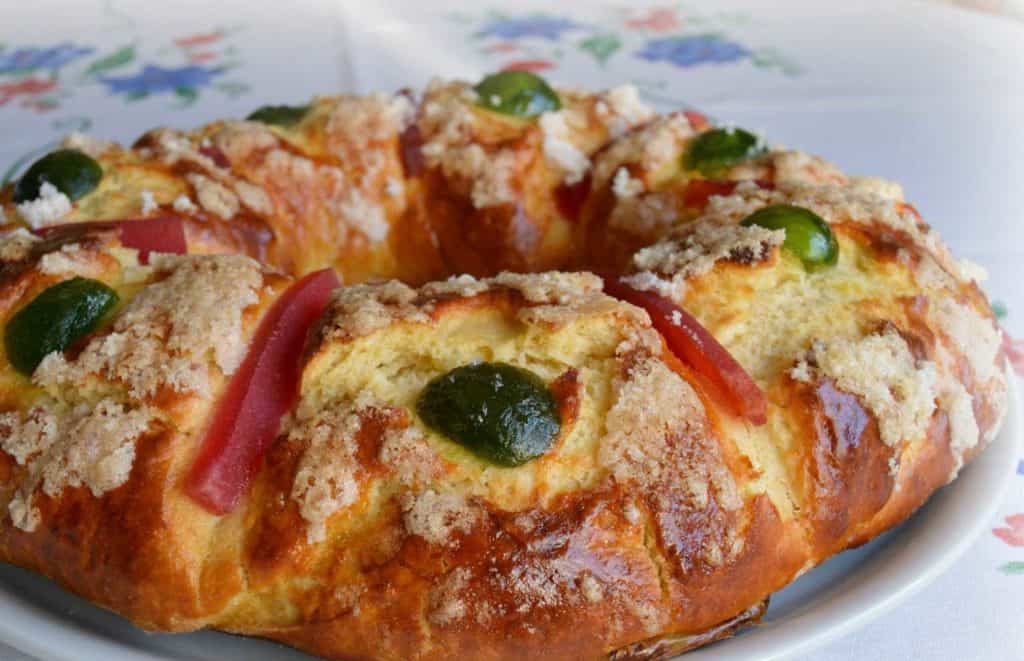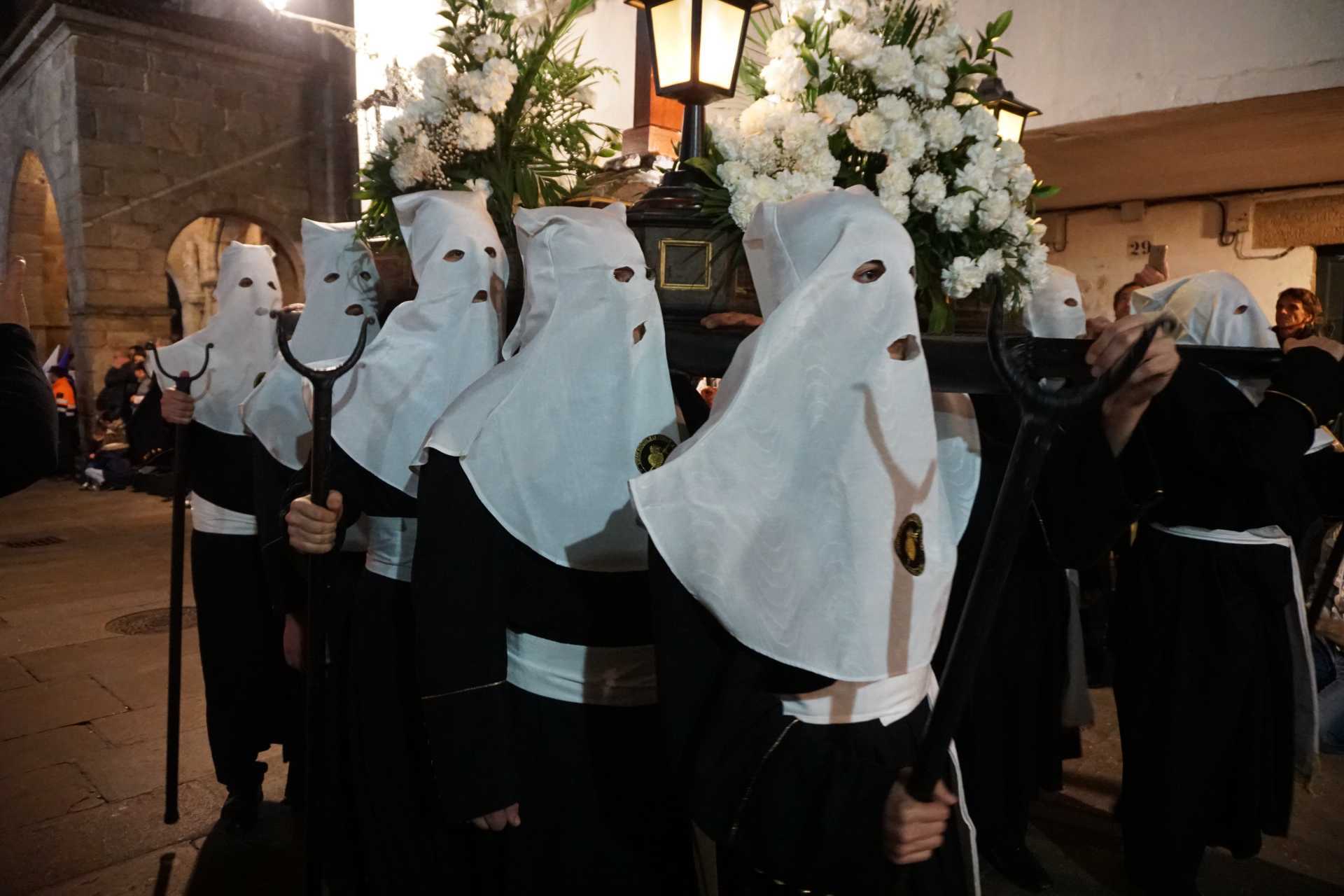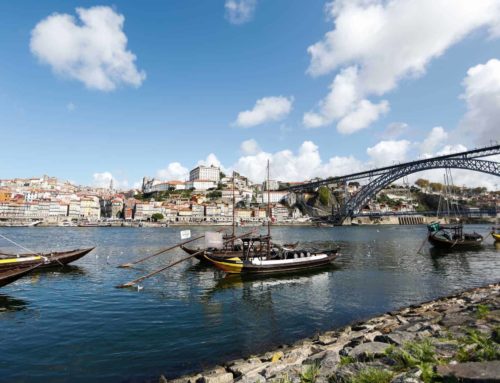Semana Santa
Semana Santa or “Holy Week” is one of the most special times to be on the Camino de Santiago. This week-long celebration fills the streets of Santiago de Compostela with processions. It is a tradition made famous in Spain as the population turns out to celebrate the Passion of Christ. The week of processions, whether you are religious or not, are an amazing sight!
Leading the processions are religious brotherhoods known as hermandades, or cofradías. They carry large floats known as pasos which depict different scenes from the gospels related to the Passion of Christ or the Sorrows of Virgin Mary. Often these floats are very large with many details. Those who carry the floats have their head covered by the traditional clothing, which is perhaps the most striking of elements.
The participants are wearing the penitential robes, or nazarenos. They look like a tunic and cloak and have a hood with a conical tip called a capirote. The colors are quite dramatic and vary between processions. The whole appearance is a throwback to medieval times when the penitents could carry out their penance without being recognized. During the parade, you will see groups wearing one color nazarenos and capirote, representing a religious brotherhood, most often from the same church or village.
During the processions these hermandades carry crosses and may also walk barefoot or shackled in chains as a penance. Marching bands with loud, slow and rhythmic drumming usually join the processions, adding a dramatic affect.
Many woman will participate in the processions wearing all black, with lacy veils to show their mourning for the death of Jesus. They often follow the floats, holding candles which is also a big tradition during Semana Santa. In the south of Spain, many kids will even have fun trying to build the largest wax ball by collecting drippings from all the people holding the candles.
These parades happen in even the smallest towns along the Camino de Santiago, so if you are walking during Easter, try to find an event. The larger cities are, of course, known for larger and more elaborate parades and floats. Some of the most elaborate religious processions take place in the Northern cities in Castilla y Leon, as well as in Seville and Salamanca.
Also, in the south of Spain, you could experience the villages coming together to sing the saeta during Semana Santa. This is a religious and very emotional song that signifies the suffering of Christ. Its origins are in flamenco folklore.
We cannot fail to mention all the foods that also are part of the celebrations. These range from a garlic soup or sopa de ajo and a cod stew with chickpeas and spinach served on Good Friday, to the sweet Bunelos, a fried doughnut also prepared during Carnaval.
One of the most popular sweet baked goods during Semana Santa are Torrijas, similar to French toast, which is seen served throughout the country during these festivities.
Vanessa’s family here in Galicia has always prepared, Rosca de Pascua, or the delicious Easter Cake Ring.
Check out the recipes for both the Torrijas and the Rosca to try your own taste of Semana Santa!

Torrijas
Ingredients:
1 cup whole milk
¼ bar of French bread, in thick slices
1 egg
Good quality olive oil
¼ cup sugar
Zest of one lemon
¼ teaspoon cinnamon
½ cup water
1 tablespoon honey
Method:
Combine milk, lemon zest, and half of the sugar (1/8 cup) in a saucepan and warm over medium heat. Bring the milk to a boil and remove from the heat. Let this cool for a few minutes.
Soak the bread slices in the milk mixture. Allow them to absorb a good amount of the liquid but not so much they will fall apart. Remove them from the milk mixture to rest for a minute and loose some liquid.
Lightly beat the egg and dip each bread slice. Flip the slices over to cover both sides of the bread.
Heat the olive oil in a frying pan. Place the bread slices into the pan when the oil is hot; cook on both sides until they are crisp with brown edges.
Mix the remaining sugar (1/8 cup) with the cinnamon. Dip each cooked bread slice into the combination, covering completely.
Take the remaining sugar mixture not used to coat the bread to make the syrup. Add ½ cup of water and the honey and bring to a boil in a saucepan. Let simmer until it becomes a syrup, don’t let the consistency become too thick.
Drizzle the syrup over the Torrijas and let them cool. Enjoy!

Rosca de Pascua
Ingredients:
6 eggs
3/4 cup of sugar
1/3 cup melted butter
Zest of one lemon
Zest of one orange
1/4 cup orange juice
One packet instant yeast
2 tablespoons of anise essence
Pinch of salt
1/2 cup whole milk
6 cups flour
Method:
Whisk eggs and sugar in a bowl. Add the melted butter, fruit zest, anise and the orange juice. Mix together but do not beat. In a separate bowl, thoroughly dissolve the yeast in the warm milk. Add to the mixture.
Next slowly add the flour and salt. Mix with an electric mixer with a dough hook or slowly add the yeast with a wooden spoon. Knead for 7 minutes or until dough is smooth and elastic. Place dough in a greased bowl and cover with plastic wrap. Set aside in a warm, draught-free place for 1 hour or until dough doubles in size.
Punch down dough, form into a ball and shape into a 10-inch round. Place on an oven tray lined with baking paper. Using your fingers, make a 3-inch hole in the center to form a ring and place a small ovenproof dish or a ball of foil in the hole. Cover with a clean tea towel and set aside in a warm, draught-free place for 1 hour or until almost doubled in size.
Preheat oven to 350°F. Brush dough with beaten egg, scatter with cherries and sugar. (Some place cream on top to place the cherries in or even add whole eggs. Get creative!) Bake for 25 minutes or until golden. Allow to cool.







[…] is one of the most special times to be on the Camino de Santiago. This week long celebration for Semana Santa or “Holy Week” fills the streets of Santiago de Compostela with processions. Easter Week is […]